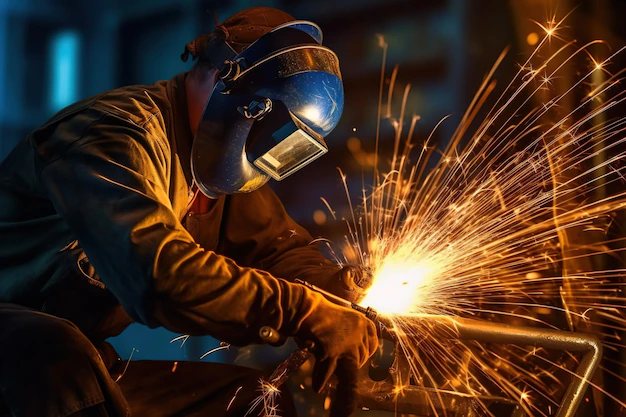The Welder Hour’s Uncovering the Mysteries

Introduction
Few occupations in handicrafts and industry are as alluring as welding. The flinging sparks, the joining of metal, and the deft hands at work forge the backbone of many constructions. But behind this blazing display is a universe of methods, tools, and tricks that sometimes go undiscovered. Hello and welcome to “The Welder Hour’s Uncovering the Mysteries,” a program where I explore the fascinating and frequently enigmatic world of welding.
The Fundamentals of Welder Hour’s
Welders follow a standard workweek, averaging around forty hours. Many manufacturing companies, the primary employers of welders, operate around the clock. These companies adopt rotating shifts spanning eight to twelve hours, spread across three to five days each week based on shift length.
Welders often seize the chance for extra hours or additional shifts, especially during crucial deadlines or staffing shortages. As their work is hourly-based, they receive rightful compensation for exceeding the forty-hour weekly threshold. This flexibility in their schedules ensures that the welding craft thrives in dynamic and demanding industries.
Is a degree necessary to work as a welder?
A degree is not required to become a welder; a certification or apprenticeship program must be completed.
Welders typically clock in around 38 to 40 hours weekly, with the potential for extra shifts and hours. As per the United States Bureau of Labor Statistics, an anticipated 3% rise in welding employment is on the horizon from 2018 to 2028.
Spatial awareness and analytical prowess form the bedrock of a welder’s skill set. Comprehension of metallurgy, welding tech, and workplace safety rules is pivotal. Dealing with volatile gases might warrant additional qualifications.
Mastering welding, a hands-on craft, can be a challenge. A high school diploma or GED and a potential welding certification are often a requisite. Completing a certificate program in six months to a year or engaging in apprenticeships offers alternative paths to proficiency, combining learning with practical experience.
types of welding jobs
- Sheet metal worker
- MIG welder
- Primary duties
- Master jeweller
- Tool and die maker.
- Welding Inspector
- Master plumber
- Structural iron and steel worker.
- Pipefitter
- Industrial boilermaker
- Fabricator
- Auto body welder
- Oil rig welder
- Construction welder
- Industrial maintenance welder
- Manufacturing welder
- Military welder
- Shipyard welder
- Underwater welder
From friction to fire
With evidence of its use dating back to the Iron Age, welding has a long and illustrious history. For instance, the Egyptians were known to join metals with pressure and heat. However, welding began to advance in the 19th century. Welders were able to produce more controlled and consistent joins after the invention of the electric arc in the late 1800s.
Numerous welding methods have been developed, each with unique advantages and uses. The most popular type of welding, arc welding, uses an electric arc to melt the metals together, whereas resistance welding creates heat using electrical resistance. While laser welding uses focused light beams to fuse metals, gas welding uses an acetylene-fueled flame. Friction welding is another unique method that creates heat by creating friction between the bonded objects.
The New Technologies Redefining Welding
The welding industry has undergone a revolution in recent decades thanks to technology. Complex welds in challenging-to-reach places are now possible thanks to developments like robotic welding arms and automated systems that have increased precision and efficiency. Furthermore, laser and electron beam welding has advanced, enabling the application of precise and localized heat. With its additive manufacturing methodology, 3D printing is even creating a stir in the welding industry, promising innovative possibilities in design and construction.
The Welder’s Arsenal:
Behind every skilled welder is an arsenal of tools and safety gear. Welders don protective equipment, such as helmets with auto-darkening visors, gloves, and flame-resistant clothing, to shield themselves from intense heat and sparks. Specialized welding machines and power sources control the arc. In contrast, filler materials like welding rods, wires, or flux-core consumables ensure solid and durable joins.
Unveiling the Welder’s Training:
Becoming a proficient welder requires extensive training in high school. Vocational schools and technical institutes offer courses in various welding techniques, teaching aspiring welders the fundamentals of metallurgy, safety protocols, and proper welding procedures. Experience and practice are invaluable, as different metals, thicknesses, and conditions demand adaptability and skill.
The Sustainability Paradigm:
In today’s world, sustainability is a paramount concern. Welding has a role to play here as well. Welding technology is evolving to minimize waste and energy consumption. Techniques like friction stir welding, which reduces material loss, and the use of advanced shielding gases that reduce emissions are gaining traction. Welders are increasingly conscious of their environmental impact, pushing the industry toward greener practices.
The Future of Welding:
As technology advances, the mysteries of welding continue to unravel. Integrating artificial intelligence and machine learning into welding processes promises enhanced precision and automation. Furthermore, developing novel materials, such as advanced alloys and composites, will present new challenges and opportunities for welders to master.
Conclusion:
“The Welder Hour’s Uncovering the Mysteries” explores a profession that bridges the gap between art and science. From its historical roots to modern applications, welding encapsulates a rich tapestry of techniques, technologies, and skills. With each spark that flies and each metal that fuses, welders shape the very fabric of our world, a testament to human ingenuity and perseverance in the face of challenges yet to be unveiled.






